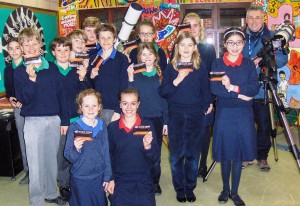 Pupils in Broadstairs had a once in a lifetime opportunity as space exploration came a little closer to home with the arrival of ‘Moon Rocks’ and meteorites at Wellesley House.
Pupils in Broadstairs had a once in a lifetime opportunity as space exploration came a little closer to home with the arrival of ‘Moon Rocks’ and meteorites at Wellesley House.
Pieces of the moon were among the very special samples visiting the independent prep school this term. Part of the school’s preparation for British Science Week, the priceless collection had to be kept under strict security conditions during its stay, locked away in the school safe, but there was also plenty of opportunity for Wellesley pupils and visitors from local infant schools and groups to get a hands-on experience. The excitement at ‘touching the moon’ was felt by children and adults alike.
The extra-terrestrial samples included a 1.2 billion year old piece of Mars and a 4.5 billion year old nickel-iron meteorite – the oldest object you will ever hold in your hands! Our solar system is only 4.6 billion years old. The lunar samples, provided by the UK’s Science and Technology Facilities Council (STFC) were collected in the late 1960s and early 1970s during some of the National Aeronautics and Space Administration’s (NASA) first manned space missions to the Moon.
In a special school assembly, Dr Kathryn McDermott from the University of Kent, talked to the children about the significance of the rocks and her work on space research. Mr John Hislop of the Thanet Stargazers astronomy club, also supported the event, which was organised by Wellesley’s science co-ordinator, Mrs Sabin-Dawson. Collaboration with a local astronomy group has been proactive in inspiring Wellesley pupils to take a real interest in space and the science behind it, even assisting in repairs to the Wellesley school telescope which is now in regular use by enthusiastic budding astronomers.
Headmaster Simon O’Malley said, “We were delighted to be able to host this unique event and to share it with other local schools and groups. Wellesley is committed to opening up a world of opportunity and inspiring scientists of the future. The ‘wow’ factor generated by the ‘Moon Rocks’ is likely to stay with pupils for a long time to come.”
The children had more opportunities to develop their scientific knowledge in the run up to British Science Week which coincided with a partial solar eclipse and a special solar telescope allowed pupils to capture the sun’s image safely. The children also had the chance to send and receive satellite messages thanks to a local radio club and to see the effects of the eclipse on the ionosphere.